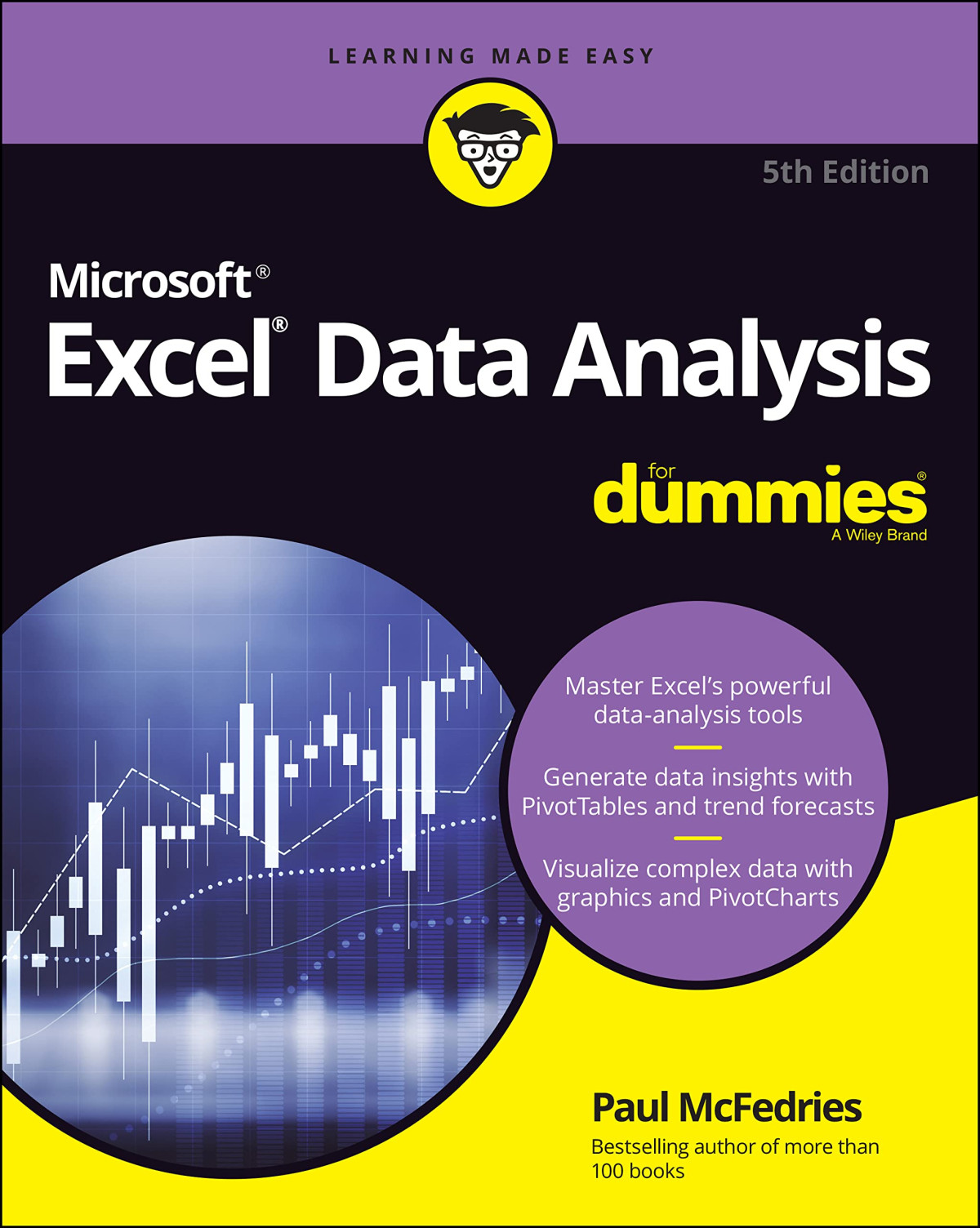

Most ebook files are in PDF format, so you can easily read them using various software such as Foxit Reader or directly on the Google Chrome browser.
Some ebook files are released by publishers in other formats such as .awz, .mobi, .epub, .fb2, etc. You may need to install specific software to read these formats on mobile/PC, such as Calibre.
Please read the tutorial at this link. https://ebooknice.com/page/post?id=faq
We offer FREE conversion to the popular formats you request; however, this may take some time. Therefore, right after payment, please email us, and we will try to provide the service as quickly as possible.
For some exceptional file formats or broken links (if any), please refrain from opening any disputes. Instead, email us first, and we will try to assist within a maximum of 6 hours.
EbookNice Team

Status:
Available4.4
10 reviews(Ebook) Excel® Data Analysis For Dummies® 5th Edition by Paul McFedries - Ebook PDF Instant Download/Delivery: 9781119844426
Full download (Ebook) Excel® Data Analysis For Dummies® 5th Edition after payment

Product details:
ISBN 13: 9781119844426
Author: Paul McFedries
PRIMARY AUDIENCE: Experienced Excel users who are looking to increase their knowledge of data analysis in Excel. Students and professionals who use Excel daily.
(Ebook) Excel® Data Analysis For Dummies® 5th Edition Table of contents:
Part 1: Getting Started with Data Analysis
Chapter 1: Learning Basic Data-Analysis Techniques
What Is Data Analysis, Anyway?
Analyzing Data with Conditional Formatting
Summarizing Data with Subtotals
Grouping Related Data
Consolidating Data from Multiple Worksheets
Chapter 2: Working with Data-Analysis Tools
Working with Data Tables
Analyzing Data with Goal Seek
Analyzing Data with Scenarios
Optimizing Data with Solver
Chapter 3: Introducing Excel Tables
What Is a Table and Why Should I Care?
Building a Table
Analyzing Table Information
Chapter 4: Grabbing Data from External Sources
What’s All This about External Data?
Exporting Data from Other Programs
Importing External Data into Excel
Querying External Databases
Chapter 5: Analyzing Table Data with Functions
The Database Functions: Some General Remarks
Retrieving a Value from a Table
Summing a Column's Values
Counting a Column’s Values
Averaging a Column's Values
Determining a Column’s Maximum and Minimum Values
Multiplying a Column’s Values
Deriving a Column’s Standard Deviation
Calculating a Column’s Variance
Part 2: Analyzing Data Using PivotTables and PivotCharts
Chapter 6: Creating and Using PivotTables
Understanding PivotTables
Exploring PivotTable Features
Building a PivotTable from an Excel Range or Table
Creating a PivotTable from External Data
Refreshing PivotTable Data
Adding Multiple Fields to a PivotTable Area
Pivoting a Field to a Different Area
Grouping PivotTable Values
Filtering PivotTable Values
Chapter 7: Performing PivotTable Calculations
Messing around with PivotTable Summary Calculations
Working with PivotTable Subtotals
Introducing Custom Calculations
Inserting a Custom Calculated Field
Inserting a Custom Calculated Item
Editing a Custom Calculation
Deleting a Custom Calculation
Chapter 8: Building PivotCharts
Introducing the PivotChart
Creating a PivotChart
Working with PivotCharts
Part 3: Discovering Advanced Data-Analysis Tools
Chapter 9: Dealing with Data Models
Understanding Excel Data Models
Managing a Data Model with Power Pivot
Transforming Data
Creating a PivotTable or PivotChart from Your Data Model
Chapter 10: Tracking Trends and Making Forecasts
Plotting a Best-Fit Trend Line
Calculating Best-Fit Values
Plotting Forecasted Values
Extending a Linear Trend
Calculating Forecasted Linear Values
Plotting an Exponential Trend Line
Calculating Exponential Trend Values
Plotting a Logarithmic Trend Line
Plotting a Power Trend Line
Plotting a Polynomial Trend Line
Creating a Forecast Sheet
Chapter 11: Analyzing Data Using Statistics
Counting Things
Averaging Things
Finding the Rank
Determining the Nth Largest or Smallest Value
Creating a Grouped Frequency Distribution
Calculating the Variance
Calculating the Standard Deviation
Finding the Correlation
Chapter 12: Analyzing Data Using Descriptive Statistics
Loading the Analysis ToolPak
Generating Descriptive Statistics
Calculating a Moving Average
Determining Rank and Percentile
Generating Random Numbers
Creating a Frequency Distribution
Chapter 13: Analyzing Data Using Inferential Statistics
Sampling Data
Using the t-Test Tools
Performing a z-Test
Determining the Regression
Calculating the Correlation
Calculating the Covariance
Using the Anova Tools
Performing an f-Test
Part 4: The Part of Tens
Chapter 14: Ten Things You Ought to Know about Statistics
Descriptive Statistics Are Straightforward
Averages Aren’t So Simple Sometimes
Standard Deviations Describe Dispersion
An Observation Is an Observation
A Sample Is a Subset of Values
Inferential Statistics Are Cool But Complicated
Probability Distributions Aren't Always Confusing
Parameters Aren't So Complicated
Skewness and Kurtosis Describe a Probability Distribution’s Shape
Confidence Intervals Seem Complicated at First But Are Useful
Chapter 15: Ten Ways to Analyze Financial Data
Calculating Future Value
Calculating Present Value
Determining Loan Payments
Calculating a Loan Payment's Principal and Interest
Calculating Cumulative Loan Principal and Interest
Finding the Required Interest Rate
Determining the Internal Rate of Return
Calculating Straight-Line Depreciation
Returning the Fixed-Declining Balance Depreciation
Determining the Double-Declining Balance Depreciation
Chapter 16: Ten Ways to Raise Your PivotTable Game
Turn the PivotTable Fields Task Pane On and Off
Change the PivotTable Fields Task Pane Layout
Display the Details Behind PivotTable Data
Apply a PivotTable Style
Create a Custom PivotTable Style
Preserve PivotTable Formatting
Rename the PivotTable
Turn Off Grand Totals
Reduce the Size of PivotTable Workbooks
Use a PivotTable Value in a Formula
People also search for (Ebook) Excel® Data Analysis For Dummies® 5th Edition:
data analysis in excel tutorial pdf
excel data analysis tips and tricks
data analysis for beginners excel and pivot tables
data analysis dummies
basic excel data analysis
Tags: Paul McFedries, Excel® Data Analysis, Dummies®